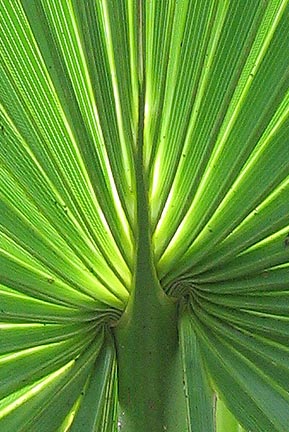a closer affinity of the putative hybrid with S. minor and S. palmetto than with S. mexicana, excluding the latter species from possible parentage.
The possibility of Sabal hybrids had been around for a long time and was noted in Scott Zona's [Flora of North America Sabal article.]
The Brazoria palmetto is easily distinguished from S. minor (dwarf palmetto) by its often strongly costapalmate leaves* and, when mature, by its trunk; from S. mexicana (Texas palmetto) by its small fruits (cf. fruit comparison). Evidence from juvenile ontogeny would seem to distinguish it from S. minor, S. palmetto and S. mexicana.
The possibility of a connection with the wild Sabal population in Fayette County - never studied - cannot be ruled out.
*Goldman notes that blades vary from "relatively flat to strongly costapalmate, the latter unlike S. minor."
The images below are of a Brazoria Sabal palmetto grown from seed from Brazoria County at the Rare Plants Study Center by Marshall Johnston and Anders Saustrup. The small palm from a 1-gallon container was planted in N. Hays County in the Texas hill country, in a constant seep with full sun in 1977. After that it received no care.
Strongly costapalmate leaf (Brazoria palmetto). |
 Weakly costapalmate leaf (S. minor). |
|---|
The Brazoria palmettos do not appear to share the inflorescence form of S. palmetto (as given in Scott Zona's FNA description "Inflorescences ... equaling or exceeding leaves in length").
Not only has the Brazoria palm shown above survived extremes of both temperature and drought for over three decades in the Texas hill country, now that it has begun to produce fruits, recruitment is appearing in the area.
Harms 40 (TEX), 17 September 2003.
Same plant, June 2007.
Brazoria palmetto leaf / inflorescence comparison.